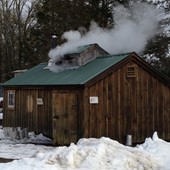How do plants overcome gravity and get water from the soil to the top of a 300 foot tall redwood tree? Why are flowering plants so diverse? How do cellular configurations help plants live on land? How do lichens interact with their symbionts? What adaptations do plants have that help them deal with extreme cold and extreme heat?
You can learn the answers to all of these questions (and more!) in classes offered in Ecology and Evolution that focus on plant diversity, evolution, ecology, structure, and physiology. If you have other questions or more in-depth questions about the ecology and evolution of plants, the EEB department also offers opportunities for students to conduct their own undergraduate research.

|
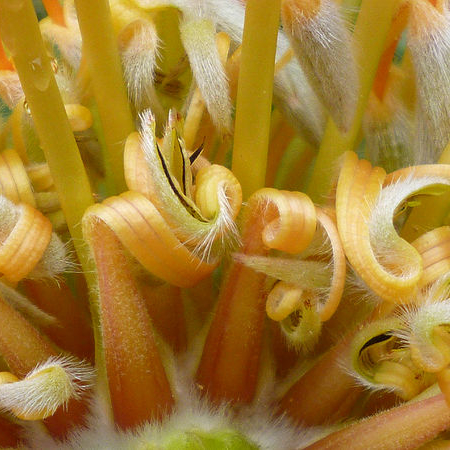
|

|
EEB 2222: Plants in a Changing World
This course explores plants biology through the lens of climate change, and in parallel, explore climate change through the lens of plant biology. You will learn a lot about both plant biology and climate change, come to appreciate the science of each, and most importantly, understand their interactions and how much that affects your lives both now and in the future.
The interactions of plant biology and climate change have significant impacts on biodiversity and environmental quality/sustainability; food quality, quantity, and security; and human health and disease. From an appreciation of this science, you will be better equipped to understand the social and political challenges and choices that you must make now and in the future.
Instructor(s): Seemann
Typically offered: Every Spring
Credits: 3
Format: Lecture and discussion
Grading: Based on quizzes and exams.
EEB 2250: Introduction to Plant Physiology
How do plants convert solar energy to biological energy that ultimately powers your life# How do they use that energy to take carbon dioxide from the atmosphere and turn it into the carbon that makes up every living organism on the planet, including you# That's photosynthesis! And believe it or not, it plays a huge role in controlling climate change! How do plants overcome gravity and get water from the soil to the top of a 300 ft tall redwood tree# Turns out they have designed a transport system that uses a really powerful source of energy for suction! How do plants take nitrogen gas out of the air and turn it into fertilizer when it's so expensive and energy-dependent for humans to do the same thing# It's a secret biological partnership! And how do plants survive when it is freezing cold in the winter or incredibly hot in the desert# How is it that plants can tell the time of day, or know what season it is# How do they know which way is up when they grow# What nasty things do plants do to insects that want to eat them# How the heck can a plant live underwater# This is just a taste of the incredible world of plants and their physiology!
Instructor: Seemann
Typically offered: Every Fall
Credits: 3
Format: Lecture
Grading: Grading is based on a midterm exam, a final, and occasional quizzes.
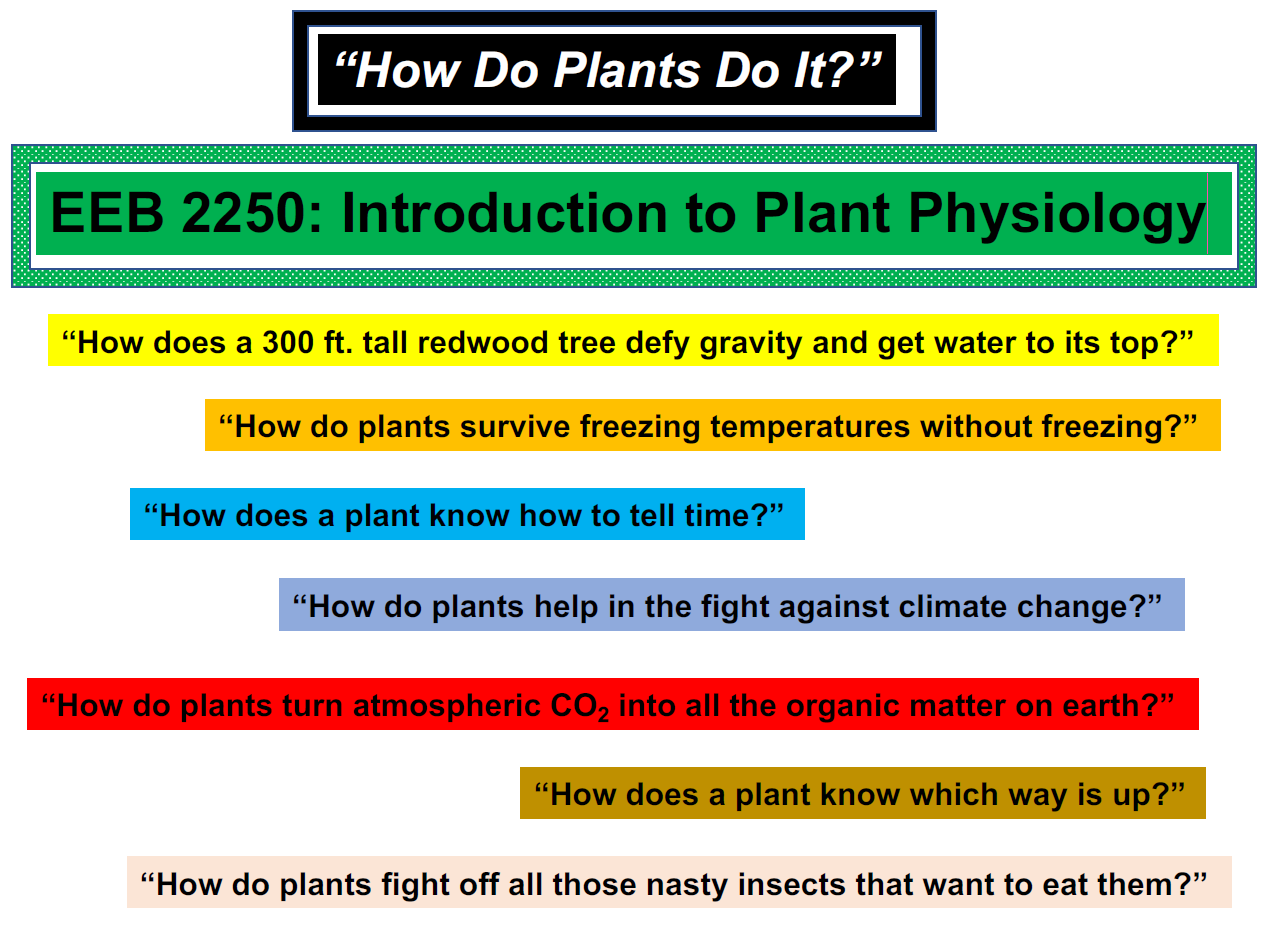
EEB 3203: Developmental Plant Morphology
This course explores the myriad variations in plant form. How can developmental modifications of three simple organs, roots, stems and leaves, result in such tremendous variation in whole plant morphology# We first learn the fundamental principles of plant construction, development and differential growth and then use these concepts to analyze an astonishingly wide variety of plants using hundreds of living plants in the EEB Biodiversity Living Plant Collection.
Instructor: Jones
Typically offered: Fall alternate years, even
Credits: 4
Format: Integrated lecture/lab in 3 hr blocks; short content lectues followed by a lot of looking at plants
Grading: 2 Midterms (Essay and drawings, lecture and lab combined); 1 Final; 1 Presentation
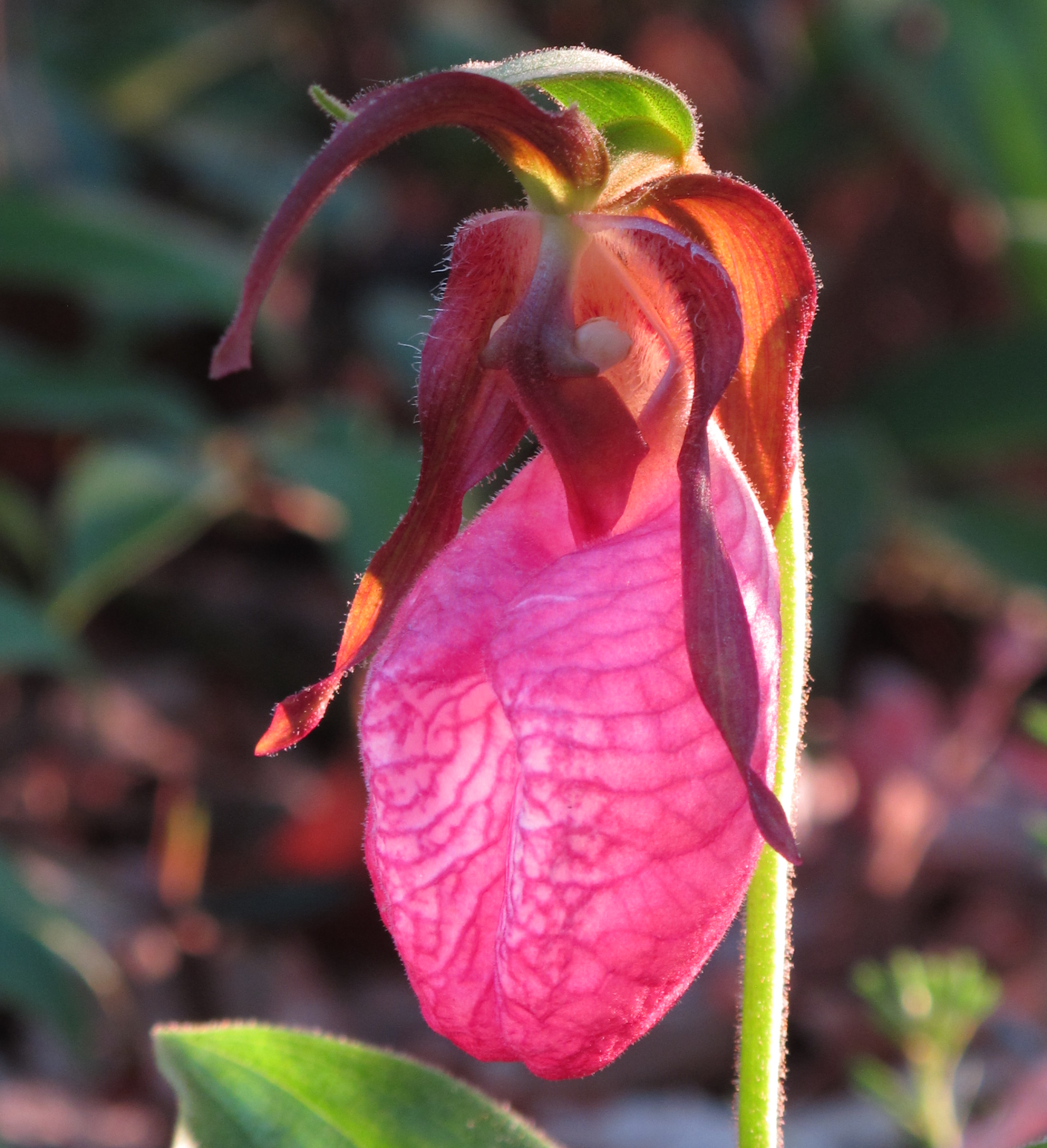
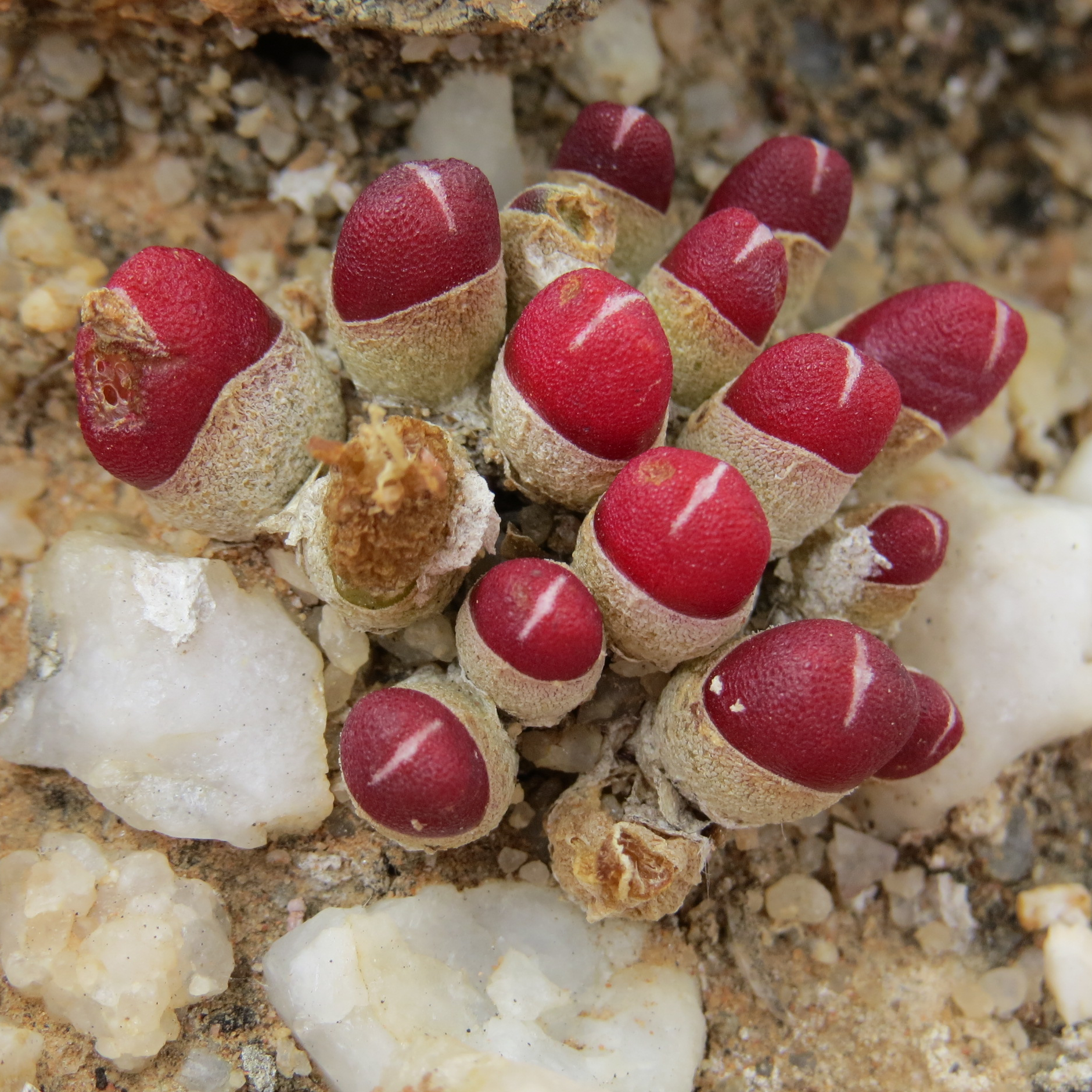
EEB 3204: Aquatic Plant Biology
Instructor(s):
Typically offered: Fall alternate years, odd
Credits:
Format:
Grading:
EEB 3220: Evolution of Green Plants
Plants are the foundation of Earth's terrestrial landscapes and critical to human civilizations. In this course we explore the evolution of morphological, physiological, and genomic traits associated with the shift of plants onto land from aquatic ancestors, and the major innovations leading to the rise of flowering plants. We discuss how plants interact with animals and fungi and how they influence global biogeochemistry. Laboratories explore the diversity of morphological and anatomical traits of living and extinct plants, apply phylogenetic methodology to morphological and molecular characters, and discuss the latest exciting research in plant evolution.
Instructor(s): Goffinet and Lewis
Typically offered: Spring alternate years, even
Credits: 4
Format: 3 h lecture, 3 h lab
Grading: Lecture: quizzes, homework, midterm, final; Lab: projects, write-ups, oral presentations, lab quizzes
EEB 3240: Biology of Bryophytes and Lichens
Bryophytes and lichens are significant components of today's biodiversity, contribute essential ecosystem functions and can even be major players in shaping changes in global climate. This course explores the morphological diversity of bryophytes and lichens, the history of their diversification, the spatial distribution of their species diversity, their ecological significance, their interaction with their symbionts and their role in biomonitoring. The laboratory sessions provide opportunities to explore the body of bryophytes and lichens, and discuss recent primary research advancing our understanding of their biology.
Instructor(s): Goffinet
Typically offered: Spring alternate years, odd
Credits: 4
Format: 3 h lecture, 3 h lab
Grading:
EEB 3250: Biology of the Algae
Algae are often thought of as either the answer to our fuel crisis, as nuisances, or the cause of harmful blooms. Algae are diverse organisms forming the foundation of marine and terrestrial ecosystems. In this class we discuss the roles of algae in shaping past and present ecosystems, how they diversified over evolutionary history, their economic uses, and how they are impacted by human activities. The lab emphasizes identification and properties of different types of algae, and optional weekend field trips provide first hand experience seeing algae in their natural environments. We also read and discuss the textbook and selected primary literature.
Instructor(s): Lewis
Typically offered: Fall alternate years, even
Credits: 4
Format: 3 h lecture, 3 h lab
Grading: Lecture: quizzes, midterm, take home final; Lab: projects, write-ups, oral presentations, lab quizzes
EEB 3256: Plants and Civilization
Instructor(s): TBD
Typically offered: Variable
Credits:
Format:
Grading:
EEB 3260: Medical Botany
Instructor(s): TBD
Typically offered: Fall Spring
Credits:
Format:
Grading:
EEB 4120: Paleobiology
In this course, we learn about the ancient Earth and the organisms that inhabited it. The lectures cover two general areas: 1) concepts and methods in paleobiology, and 2) the chronology of life’s history as documented in the fossil record. We discuss all types of organisms, although the focus is on animals, and to a lesser extent plants. In lab, students learn to identify and interpret major groups of fossils using (mostly) real fossil specimens.
Instructor(s): Bush
Typically offered: Spring alternate years, even
Credits: 4
Format: 3 credits of lecture, 1 credit of lab, 1 field trip (weather permitting)
Grading: Grading is based on 2 midterm exams, the final exam, and the lab assignments
EEB 3271: Systematic Botany
Instructor(s): Yuan
Typically offered: Spring alternate years, odd
Credits: 4
Format: NA
Grading: NA
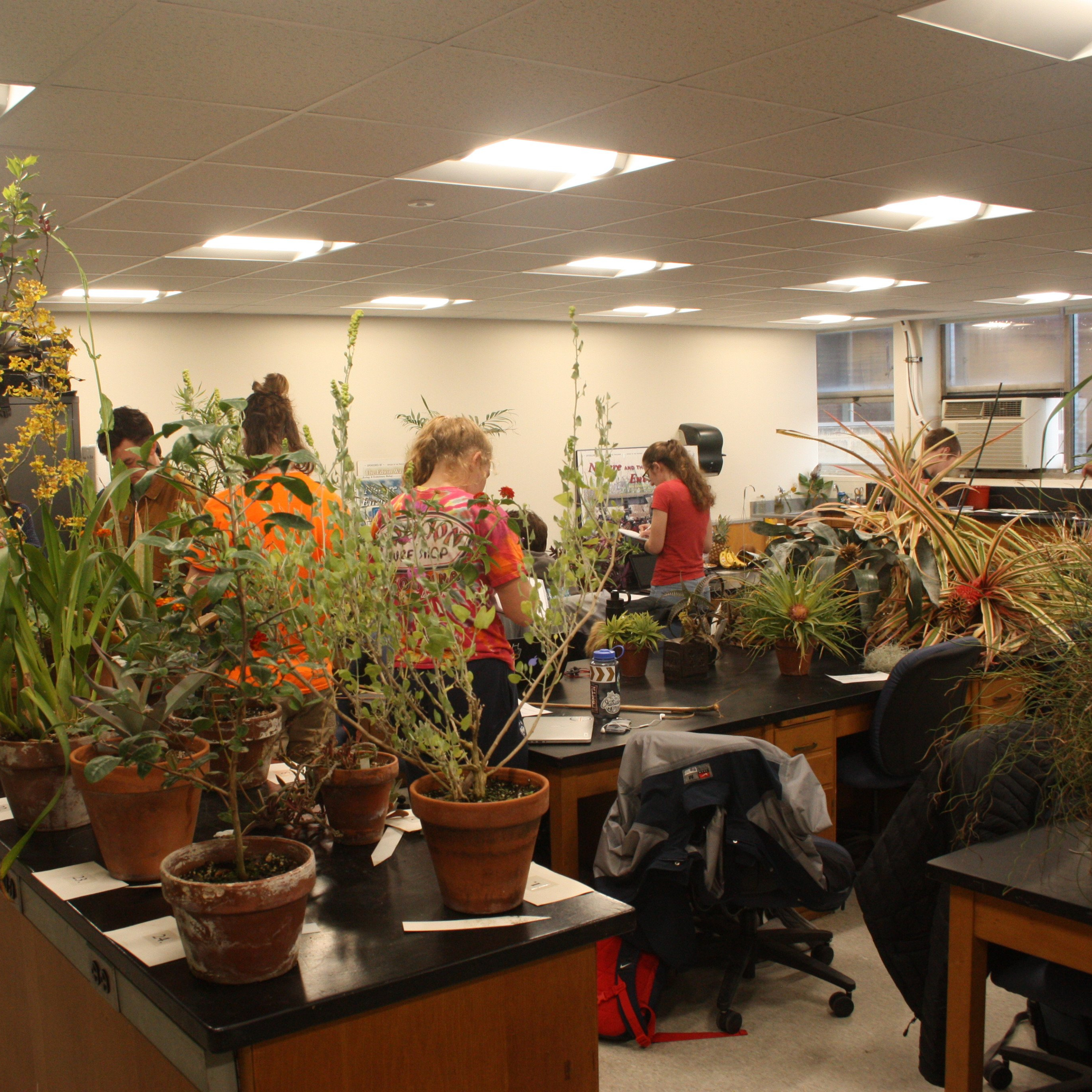
EEB 3360: Physiological Ecology of Plants
The biggest challenges of being a plant are that they can't go inside when it gets too hot or too cold, they can't move around till they find something to eat, they can't pick up and leave when there is nothing left to drink where they currently are, and when a bug comes to eat them, they can't call an Uber. Rather, plants have to figure out how to take light from the sun, carbon dioxide from the air, and water and nutrients from the soil under the often really tough environmental conditions of where the seed that produced them happen to sprout. Plants have to figure out how to do this in a desert when it is really hot, or in the alpine, where it is really cold. They have to figure out how to do this when there is almost no light when they are trying to grow at the bottom of a tropical rainforest, or when there is too much light (yes, avoiding sunburn is a real problem for plants too!). Plants have evolved an amazing array of physiological processes and adaptations that allow them to not only cope with the many challenges of the earth's diverse environments, but to prosper in the most brutal of climates, to make the world the green place we see when we step outside, and to be the fundamental source of food for our existence. And as if they don’t have enough to do just to survive, plants serve on the front line of fighting back against the human-caused rise of carbon dioxide in the atmosphere that is driving global climate change.
Instructor(s): Seemann
Typically offered: Fall alternate years, even (note: this course is currently not being taught due to high demand for EEB 2250)
Credits: 3
Format: 3 hr Lecture
Grading: Grading is based on a midterm exam, a final, and occasional quizzes.
EEB 4272: Summer Flora
This course focuses on the botany, systematics, and ecology of Connecticut's native and exotic plants. Students learn basic field botany skills including: writing detailed field notebooks, identifying local plants, making field presses, mounting herbarium records, and recognizing common New England habitats. This course relies primarily on outdoor field trips and is well suited to students who are interested in careers within wildlife management/field biology or who simply desire an in-depth knowledge of the nature surrounding UConn.
Instructor(s): TBD
Typically offered: Summer
Credits: 3
Format: Lecture, Laboratory, daily field trips
Grading:
EEB 4276: Plant Structural Diversity
This course explores internal structure of plants from a functional perspective. We combine microscope studies of plant anatomy with ecophysiology to examine how variation in the cellular configurations leaves, stems and roots reflects various adaptations to living on land. We approach increasing complexity from a phylogenetic and developmental perspective, building the plant body from embryos through flowers.
Instructor: Jones
Typically offered: Fall alternate years, odd
Credits: 4
Format: Integrated lecture/lab in 3 hr blocks; short content lectues followed by a lot of looking at plants
Grading:
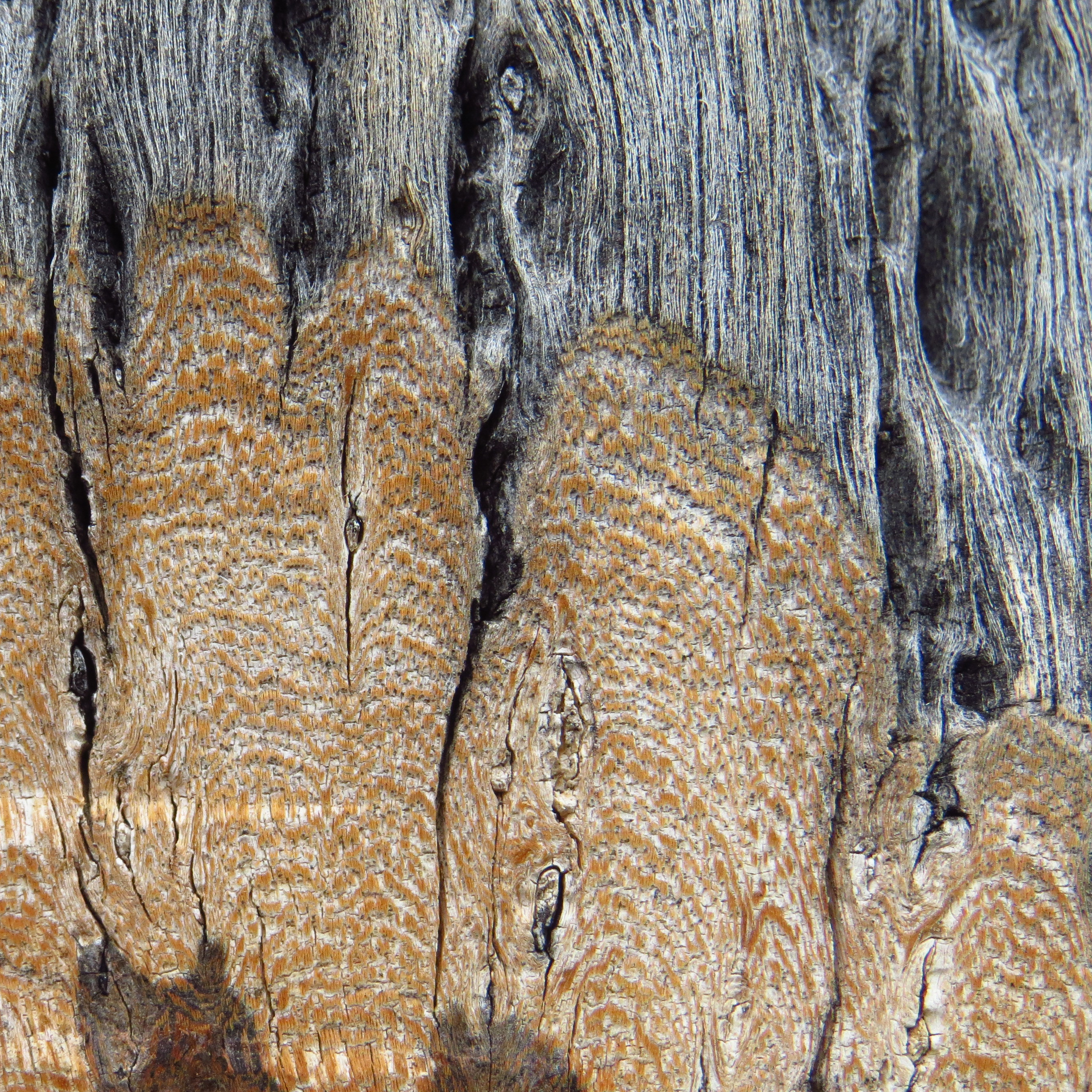
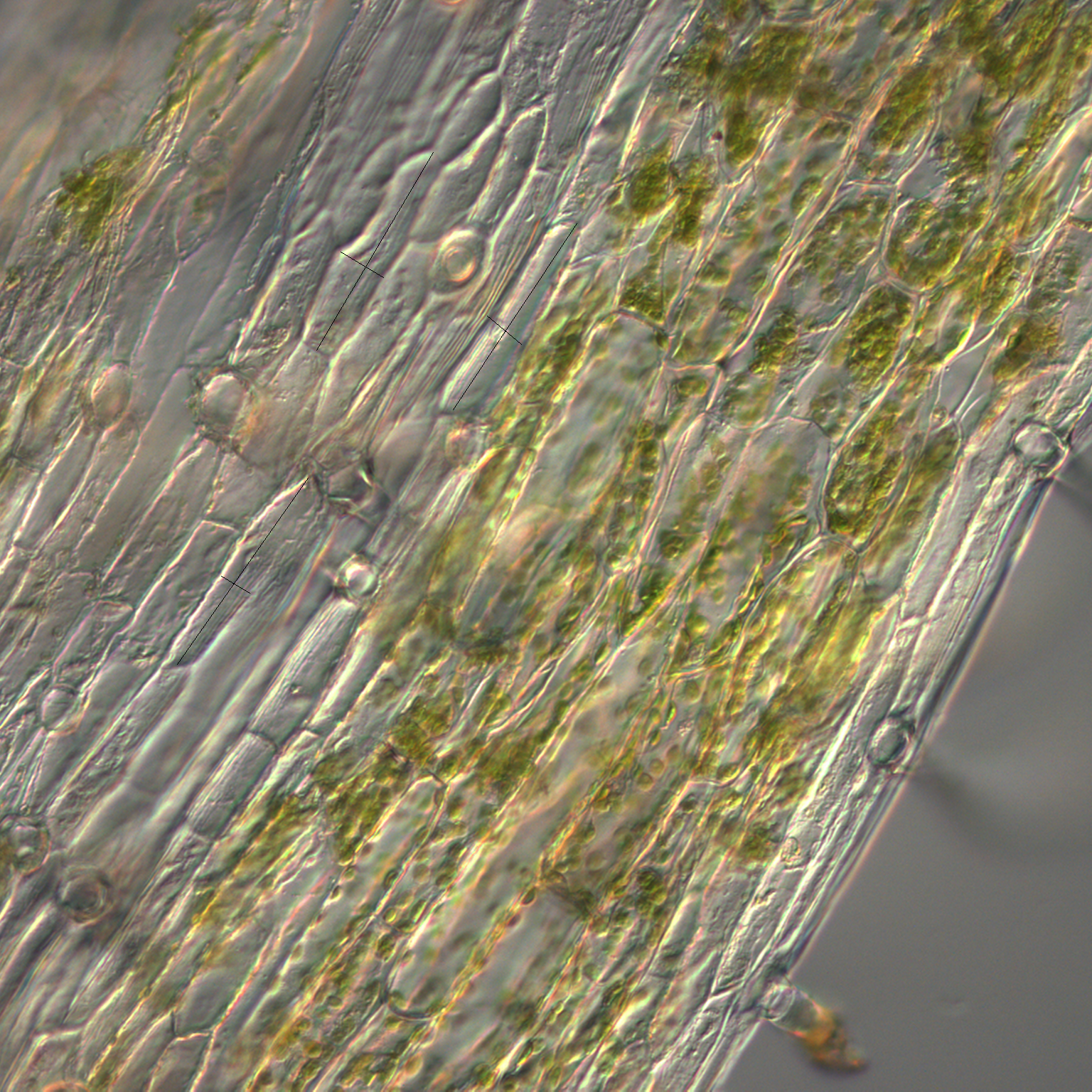
Undergraduate Research
EEB faculty offer opportunities for undergraduate students to work on research during the summer or academic year. Students can participate in lab and field work on projects ranging from floral traits, to gene expression in trees, to plant structure. Each year, the department hosts an undergraduate research symposium for EEB students, from which several students are selected to present at the Biology Undergraduate Research Symposium. To get involved in research in EEB, read through faculty profiles and websites and contact a faculty member whose research interests you.
Many faculty also mentor independent projects led by students, especially for students applying for funding to conduct research through the Office of Undergraduate Research (OUR). Examples of recent undergraduate research projects in the EEB department funded by OUR include:
- Development of an Open-Source, Web-Based Database Module for the Tripal Framework to Improve Eukaryotic Genome Annotation
- The Genetic Architecture of Pollinator-Associated Floral Traits in Monkeyflowers
- Impact of Climate Change on Mutualistic Soil Fungi and Their Interactions with Native Maple and Oak Seedlings
- Transcriptomic Analysis of the Needle-Dropping Period for the Eastern Larch (L. laricina)

